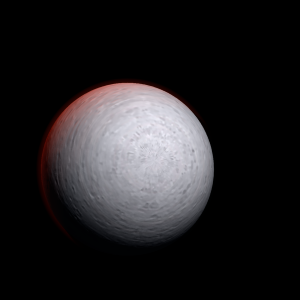|
|
Space Astro
|
Info for exoplanet "Orix"
| Scientific (actual) data |
|---|
| Name | HD 141399 d |
| Planet status | Confirmed |
| Mass sini | 1.18 |
| Orbital period | 1069.8 |
| Semi major axis | 2.09 |
| Orbit eccentricity | 0.074 |
| Discovered | 2014 |
| Updated | 2016-02-17 |
| Omega | 220 |
| Tperi | 2456920 |
| K | 22.63 |
| Publication | Published in a refereed paper |
| Detection type | Radial Velocity |
| Mass measurement type | Radial Velocity |
| Star name | HD 141399 |
| Right ascension | 236.73° |
| Declination | 46.99° |
| Mag v | 7.2 |
| Star distance | 36.17 |
| Star metallicity | 0.35 |
| Star mass | 1.07 |
| Star radius | 1.46 |
| Star sp type | K0V |
| Star temperature | 5600 |
| Wikipedia article | HD 141399 d |
Back
| |
| Fictional info (?) |
|---|
| Suggested name | Orix |
| Planet type | Cold planet |
| It is the coldest planetary atmosphere in its solar system, with a minimum temperature of 33°K (-240°C), and has a complex, layered cloud structure with oxygen thought to make up the lowest clouds, and sulfur dioxide the uppermost layer of clouds.
The polar regions are constantly below 270°K (-3°C).
It was the one of the first exoplanets visited by a spacecraft, and one of the first to be successfully landed on. |
| Atmosphere | Sulfur dioxide | 70% |
| Oxygen | 21% |
| Xenon | 8.4% |
| Atmospheric pressure | 17 bar |
 |
| Moon | Thekeron-hyr | Small potato shaped ice asteroid |
| Koaruqpuck-eume | Huge round crater-filled moon |
| Iolaslin | Large slightly egg-shaped oceanic comet |
| Saocor Dene | Large potato shaped rocky planetoid |
| Turso'epi | Medium-sized round gaseous moon |
| Iakatia One | Medium-sized round gaseous asteroid |
| Noemne Orio Nar | Very small irregular rocky comet |
| Thimepa'farivos | Large round rocky moon |
| Idxides Cor | Small irregular gaseous moon |
| Google search for Orix |
|
Website by Joachim Michaelis
|
|
|
|